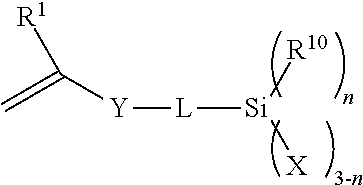Antireflection film, polarizing plate and image display utilizing the same
a technology of polarizing plate and antireflection film, applied in the direction of polarizing elements, coatings, instruments, etc., can solve the problems of loss in the agglomerating power of the binder itself, difficulty in realizing a refractive index of 1.40 or lower, and the reduction of the refractive index has a certain limit in practice, so as to suppress glare and reduce the trace of attached water drop. , the effect of low reflectan
- Summary
- Abstract
- Description
- Claims
- Application Information
AI Technical Summary
Benefits of technology
Problems solved by technology
Method used
Image
Examples
example 1
Preparation Example 1
Preparation of Inorganic Fine Larticles (P-1)
[0267]360 g of tetraethoxysilane (TEOS, SiO2 concentration 28 weight %) and 530 g of methanol were mixed, then the mixture was subjected, at 25° C., to respective dropwise additions of 100 g of ion exchanged water and an aqueous ammonia solution (containing 28% of ammonia), and ripened for 24 hours under agitation. Then the mixture was heated in an autoclave for 4 hours at 180° C., and subjected to a solvent replacement to ethanol utilizing an ultrafiltration membrane to obtain a dispersion liquid of inorganic fine particles (P-1) with a solid concentration of 20 weight %.
preparation example 2
Preparation of Inorganic Fine Particles (P-2)
[0268]A mixture of 100.0 g of the inorganic fine particle (P-1) dispersion liquid prepared in Preparation Example 1, 900 g of ion-exchanged water and 800 g of ethanol was heated to 30° C., then 360 g of tetraethoxysilane (SiO2 concentration 28 weight %) and 626 g of a 28% ammonia solution were added to form a silica shell layer by a hydrolysis-polycondensate of tetraethoxysilane on the particle surface. The reaction mixture was concentrated in an evaporator to a solid concentration of 5 wt.%, then brought to a pH value 10 by an addition of an ammonia solution of a concentration of 15 weight %, then heated in an autoclave for 4 hours at 180° C., and subjected to a solvent replacement to ethanol utilizing an ultrafiltration membrane to obtain a dispersion liquid of inorganic fine particles (P-2) with a solid concentration of 20 weight %.
preparation example 3
Preparation of Inorganic Fine Particles (P-3)
[0269]Inorganic fine particles (P-5) were prepared in the same manner as the organic fine particles (P-2) except that an amount of tetraethoxysilane (SiO2 concentration 28 weight %) was changed from 360 g to 470 g.
PUM
| Property | Measurement | Unit |
|---|---|---|
| particle size | aaaaa | aaaaa |
| refractive index | aaaaa | aaaaa |
| particle size | aaaaa | aaaaa |
Abstract
Description
Claims
Application Information
 Login to View More
Login to View More - R&D
- Intellectual Property
- Life Sciences
- Materials
- Tech Scout
- Unparalleled Data Quality
- Higher Quality Content
- 60% Fewer Hallucinations
Browse by: Latest US Patents, China's latest patents, Technical Efficacy Thesaurus, Application Domain, Technology Topic, Popular Technical Reports.
© 2025 PatSnap. All rights reserved.Legal|Privacy policy|Modern Slavery Act Transparency Statement|Sitemap|About US| Contact US: help@patsnap.com



